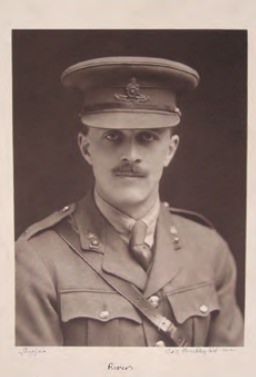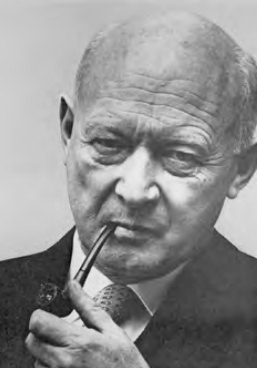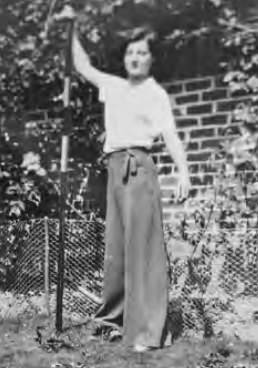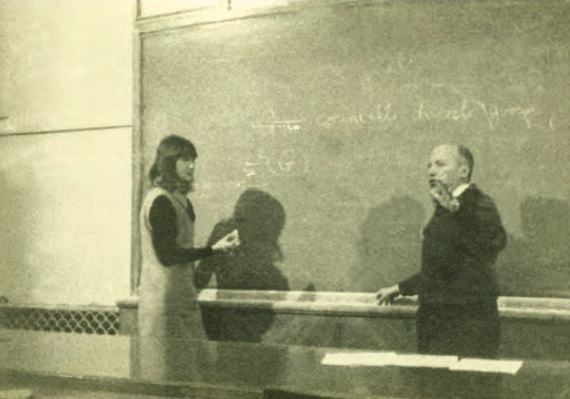by Dusa McDuff
On two different occasions recently, (male) mathematicians asked me in all innocence: But you surely never suffered any discrimination? This essay is partly in response to them and partly amplifies a talk I gave last year to participants in the GROW conference about my family background. I am convinced that it is only because there was such a strong academic tradition in my family (among both women and men) that I survived as a mathematician. One indication of how rare this was is the fact that no female mathematicians were elected as Fellows of the Royal Society of London for the almost fifty years between 1947, when Dame Mary Cartwright became the first such Fellow, and 1994, when I was elected.

My mother’s father, George Rivers Blanco White (1883–1966), pictured in Figure 1, studied mathematics at the University of Cambridge, was a junior wrangler (i.e., he placed second in his year in the final exams), and chose to fight as a private rather than an officer in the First World War in an artillery unit in the trenches (calculating trajectories). Socially progressive, he became a lawyer and eventually a distinguished divorce court judge. I met him only a few times, but my mother had been close to him and told me about him.
My father, Conrad Hal Waddington (1905–1975), pictured in Figure 2, was a distinguished developmental biologist, geneticist, and thinker, whose work is still well known today because he was one of the forefathers of systems biology. I was closest to him when I was about thirteen, when he was writing The Ethical Animal, his attempt to formulate a scientific justification for morality, and I spent evenings in his study discussing his ideas. He didn’t have much time for mathematics, thinking it too dry and boring.

My mother, Margaret Justin Waddington, pictured in Figure 3, was a trained architect and town planner with a full-time job in the civil service in Edinburgh, designing council housing and later doing research into the most efficient designs for emergency rooms in hospitals. It was very unusual for married women to have professional careers in Edinburgh, which was one reason why our family had very few friends there. Another reason was the effect of the war: my father was rewarded for his distinguished war work by the Professorship in Edinburgh, but almost all my parents’ friends remained much closer to London. Despite having to work in a government office after the war, in the 1930s she did manage to build a house in the modernist style that is now a \( 2^* \) listed building, an honor in Britain.
I was always expected to get an advanced education, have a career, and be self-supporting — again, unusual for the time and very helpful, because that was one battle I did not have to fight. Also, I hardly had to fight for the decision to study mathematics. I had always excelled at it, and my school had a wonderful mathematics teacher who showed me the beauty of Euclidean geometry and the elegance of calculus.

However, I did have to fight the battle of how to be both a woman and a mathematician. Although as a teenager I had almost no idea what either of those identities might be, it was certainly not to be a “bluestocking,” i.e., a serious, essentially sexless old maid (you see all the prejudices). By the time I was fifteen or so, I also had quite a bit of scorn for women. I went to an all girls’ school, which, in retrospect, had many advantages, but the teaching was not as rigorous as that in boys’ schools, and a significant cohort of the girls were there to learn to be young ladies and future wives. Even to go on to university rather than Atholl Crescent (a finishing school in Edinburgh where one learnt to be a wife) was quite a step.
I know very little about my great-great-grandmother, Mrs. Robison. The reason for her rather resigned expression in Figure 5 will become clear, as will that for my great-grandmother Maud’s sourness. Maud (1865–1953) was remarkable. She was part of a group of women who won Votes for Women in New Zealand in 1893 — the first country in the world to achieve this. Coming to London in the 1890s, she joined the Fabian socialists, founded their women’s group, and as part of a project with them wrote Round About a Pound a Week, a book about the London working classes in 1912 that is still in print today and was recently used as a sociology text in Stony Brook University. (Incidentally, I still get more royalties from that book than I do for my own.) I never met Maud: my mother had deeply offended her and there was no communication.

The central figures in Figure 5 are my grandmother Amber and her daughter Anna-Jane. There was a big scandal in London about Amber’s pregnancy and Anna-Jane’s birth because the father was H. G. Wells. Though HG was firmly married and with children, he and Amber had fallen in love a few years before.1 He wrote several books about her, notably Ann Veronica, a novel featuring the “new woman.” Though this new woman is very appealing and intellectually alive, in the end Ann Veronica marries the teacher she so inspired and then essentially ceases to have an independent life — at least Wells goes no further with the story.

My grandmother, of course, did go further with her story. My grandfather, who had loved her in their student days in Cambridge, married her while she was pregnant, for which she was always very grateful. Besides having three children, she wrote some novels (A Lady and Her Husband was recently reissued), and other books such as one about economics for the Left Book Club, Worry in Women, and Ethics for Unbelievers inspired by Confucius’s philosophy. After the Second World War she taught philosophy at Morley College (now part of the University of London). However, she was considered by both my parents to have been without a real career and to have largely wasted her talents. My father once remarked that she could have had a wonderful life in London: she was very attractive, knew everyone, and could have been the mistress of the likes of Bertrand Russell — “What a wasted opportunity!” he said. But she always thought that HG was the most brilliant man she had ever met.
Looking back now, I think she did remarkably well, considering that between the wars, when there was so much unemployment, it was not considered proper (and often simply not allowed) for married women to have full-time jobs. However, she (as well as my mother and my younger self) thought that boys were better than girls. There was no family tradition that women could be as good as men. My mother’s solution to the problem was to ignore the fact that I was female, a fine approach when I was young, but not much help to me in navigating adolescence.
Dusa was the name HG used for Amber, because she had long black snaky hair. (I later learnt that HG had a different version: in his essay On Loves and the Lover Shadow about his love life, he said that Amber had chosen it for herself as a teenager, because she identified with Medusa’s head held up by Perseus in Bernini’s statue.) Since I was called after her, I was very affected by her story. Identifying with the monstrous Gorgon2 made me feel unique, which was both good and bad. I could certainly never settle for something I considered ordinary, a great impetus for me to continue to try to find my way in mathematics. On the other hand, I had very unrealistic ideas about what kind of woman I wanted to be (or could be), and I also had to find a genius equivalent to HG….
I did find my genius (a fledgling poet). He had the good quality of being completely amathematical (because he couldn’t pass the arithmetic exam to get into Edinburgh University, he had to do a paper in botany), which meant that I was completely free in that respect. In the course of his PhD in Russian symbolist poetry, we managed to go to Moscow together for six months in 1969–70, where I studied with the great I. M. Gel’fand. This had an enormous influence on my mathematical development. So despite the many difficulties, living with a poet did in the end spur my career.
In 1967 I went as a graduate student to Cambridge, without realizing that the decision of where to study and whom to study with was at all consequential. Starting out in functional analysis, I studied von Neumann algebras with George Reid, who had recently returned from a year at Tulane. During my second year, he showed me a recent paper by another graduate student who had just discovered a third \( \mathrm{II}_1 \) factor.3 Quite quickly, I managed to extend these new ideas. During a meeting where I showed seventeen or so new factors to George, he remarked, “If only you could iterate one of these constructions….” That seed was enough for me to find an iteration process that allowed the construction first of countably many and then of uncountably many different \( \mathrm{II}_1 \)-factors. This work was published in the Annals of Mathematics; its existence helped me to get jobs and was a great moral support for many years.

Figure 6 shows a photograph of me in Moscow, Fall 1969, at Gel’fand’s seminar. When I got there, I knew very little mathematics. Gel’fand opened my eyes to number theory, manifolds, topology, homotopy theory, homological algebra, Lie groups… 4 After Moscow, I came back to Cambridge for two years, taking Gel’fand’s advice to become a topologist. It was a time of learning, both to be a topologist and a mother. I felt very isolated and ignorant: it would have been very helpful to have a mentor at this time, someone to encourage me and suggest problems for me to work on. Because I had totally switched fields, no one felt responsible for looking out for me, though, to be fair, some people did help me at a few crucial moments in the next few years: supplying money to go to a conference in the US, giving me a job at the University of York, and later inviting me to fill a visiting position at MIT.
Was I ever discriminated against? There are two kinds of discrimination: explicit and implicit. For the most part, explicit discrimination did not affect me much. However, in retrospect, implicit discrimination — for example, the fact that I was so isolated as a postdoc because I could not share in college life — as well as my own internalized misogyny, did have a significant effect, though I hardly noticed this at the time. Another important factor, and one that I was aware of, was pervasive but not overt: it was very rare that women became professional scientists in Britain at the time, largely because science (and particularly “hard” as opposed to “life” science) was considered such a very unfeminine thing to do. Even I thought it was unfeminine, and I had therefore to show my femininity in other ways: for example, my mother never did any housework and kept her maiden name professionally, while I, ever the contrary teenager, gloried in cooking for my boyfriend and changed my name when I got married. I always felt alone, had no cohort of friends for mutual encouragement. Even when the second-wave women’s movement got started in Britain, I thought it was irrelevant to me, since they were fighting the battle of taking their professional lives seriously, while I was already responsible for supporting my family. These days, when most of the obvious barriers to women’s participation in mathematics have been removed, there still remain very strong and insidious internal barriers, shown in such phenomena as stereotype threat or imposter syndrome. The prejudices that lead to people accepting as completely normal that women should not get degrees at Cambridge (they first could get Cambridge degrees in 1948) are very strong and do not disappear immediately when the external barrier is removed.
In the 1960s there were, of course, very visible manifestations of the idea that academic life is not for women. At the time, most Ivy League universities in the States did not admit women, and in Britain almost all the colleges at the most prestigious universities (Oxford and Cambridge) were single sex. As a graduate student, I was a member of Girton College, Cambridge, but I never went there for several reasons: it was several miles away from the town center, research was done in the department rather than in colleges, I was too prejudiced against women to think it worth exploring Girton, and, like all other colleges at the time, Girton had no provisions for married students. The male students, of course, did dine in their colleges, which were also in the town center. In the early 1970s when some male colleges began to admit women, my thesis advisor, George Reid, told me that as far as he was concerned this would only happen at his college over his dead body. So I did feel excluded. Even in the mathematics department, the few women were either going to get married when they graduated or were going back to their home abroad or were very marginalized. There were no role models to show the way or even an incipient women’s movement with which to develop awareness and plot resistance.
The most discriminatory situation I encountered was when I was trying to get a job in Cambridge after my postdoc. I was married with a husband and baby to support, but the better paying fellowships were at men’s colleges so that I could not apply, while Girton was too poor to pay enough for a family to live on. There had been an open university lectureship the previous year, which I was eligible for. But no one told me about it, and I was completely out of the loop. In fact, the way I heard about this was when George Reid said to me at one point: “What a pity you didn’t apply for that job last year….”
So I had to leave Cambridge, possibly a good thing in the end. Obtaining one of the few lectureships available in the UK that year, I enjoyed my time as a young faculty member in York, starting to work with colleagues, making friends, and leading a somewhat more normal life. In the summer before going to York, I went to a conference on K-theory at the Battelle Institute in Seattle (incidentally, my first visit to the US), where I met Graeme Segal. We started a collaboration, in which I first functioned much as a graduate student, but gradually became a somewhat more equal partner. As an indication of my state of mind then, here is the story of my meeting with Armand Borel in Seattle. On the first morning of the meeting, I was up very early with jet lag and had a very pleasant breakfast conversation about jazz clubs in New York with an intelligent and friendly man. When I discovered later that my breakfast companion was Borel, I said not one more word to him. Even later, when I visited the Institute for Advanced Study I never talked to him: I simply felt I knew too little to face him.
I could well have stayed in York (and as a result perhaps done rather less mathematical research) but didn’t, because, no doubt on Gel’fand’s recommendation, I was offered the wonderful opportunity of a year as a visiting assistant professor at MIT in 1974–1975. One of the first institutions to actively promote women in science, MIT had reserved this position for a woman. In my case, this intervention was very successful, since it gave me a chance to become part of a top-level research community. After that I finally began to function more independently, creating opportunities for myself, having new mathematical ideas, and slowly rebuilding confidence that I really could do mathematics. Finally I got to the following stage: I was talking to Raoul Bott for the first time, explaining something that I was working on with Graeme Segal, and I said, “I thought that…,” which he interrupted with “You thought?” I confidently replied, “Yes!” and continued with my explanation.